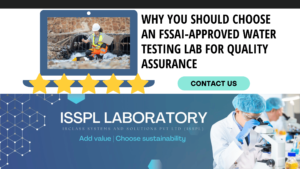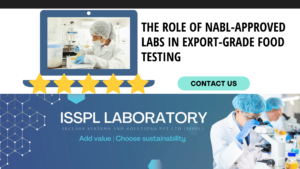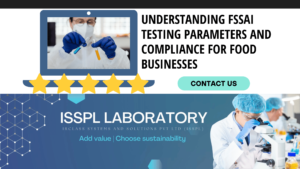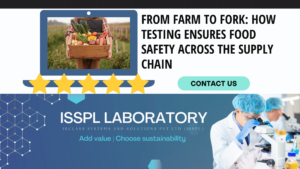An Overview by Team ISSPL - Analytical Testing Laboratory in India
ToggleFood preservatives and additives are substances that get added to food and consumable products during the various steps of food processing. It is part of the food industry or preparation stage. One needs to put the preservatives and additives to improve the food’s flavor, texture, color, appearance, and shelf-life. The additives are vital to improve the nutritional value and food quality as well.
The food additives can be preservatives, sweeteners, stabilizers, thickeners, emulsifiers, colors, and flavorings. For instance, the common products include – sodium benzoate (a preservative), ascorbic acid (vitamin C), carrageenan (a thickener), monosodium glutamate (a flavor enhancer), etc. The preservatives are regulated by government agencies across the world. The world-famous agencies review the quality, utility, and safety of food additives before approval. They also determine the limits of the additives in the food. It is part of the regulatory compliance to mention the additives used on food labels. It helps the buyers make an informed choice.
Testing the samples – The essentiality
Food additive testing is an extensive process of evaluating the safety and effectiveness of food additives. The testing for food additives is critical to review the intended purpose, like – improving the food flavor or preserving the food quality. It is also vital to review the potential risks the additives can pose to human health. Food preservative testing includes extensive forms of studies and research techniques. For instance, toxicology studies can evaluate the potential health impacts of the additives and preservatives in food. Other studies and testing techniques are critical to assess the stability of the additive over time.
Preservative testing is carried out by regulatory agencies and food manufacturers. It helps them ensure compliance with regulatory norms. Food additive testing is critical to ensure food safety and quality in the supply chain. One can rely on the testing results to provide consumers with relevant and accurate information about the food ingredients. Assessing the food additives can help set the ideal limits on the food preparation techniques as well. The food regulators and manufacturers can use the information to make the food safe, stable, nutritious, and enjoyable.
Preservatives in cosmetics – Industries that need testing measures
Preservatives are also critical for the beauty and cosmetics industry. It plays a prime role in the development and safety of cosmetic products. They can prevent microbial contamination and facilitate product maintenance. In the long run, preservatives help ensure consumer safety. The various types of preservatives in cosmetics have their unique significance. Hence, the testing techniques are unique, reviewing their essentiality in the product. The testing results help manufacturers and consumers to decide the best products to use. The food industry is not the only industry that requires the assistance of testing labs for preservative assessment.
Regulatory requirements for preservatives in cosmetics
Food preservatives are vital to check, and regulatory bodies, like the FDA in the United States and the EU Cosmetics Regulation in Europe, make the testing measures mandatory at various stages of development and supply. The statutory bodies have established norms and restrictions regarding preservatives in cosmetics and food. Compliance with the world-class norms is integral to carrying out trade. It also ensures consumer safety and helps the manufacturers abide by the legal obligations. Preservatives must undergo intensive testing steps in order to get approved by regulatory authorities.
Common preservatives in food – The testing fundamentals
Class I – The naturally available food preservatives are – common salt, sugar, dextrose, spices, vinegar, honey, and edible vegetable oils.
Class II – The chemically synthesized food preservative compounds are – benzoic acid and its salts, nitrates or nitrites of sodium or potassium, sulfurous acids, and their salts, etc. All these are used in foods with prolonged shelf-life, like ham and pickled meat.
Preservatives are the ideal solution to increase the shelf-life of a food product without reducing its nutritional value. It defines the purpose of the preservative usage in the food products. One can also find antimicrobial preservatives in food to prevent food degradation through bacteria. It is an effective method for traditional food preservation. A common example of an antimicrobial preservative is lactic acid.
Quality control and preservative testing – The essentialities
Food additives and preservatives require approval from the FSSAI before putting them in the food products. The FSSAI approves a preservative if it has appropriate scientific data and exhibits chemical stability and safety. It also reviews the intended purpose and utility. One can also find international laws and regulations related to the use of preservatives. The FSSAI determines critical guidelines and defines the permissible limits of using preservatives in a food product. Hence, abiding by the regulatory norms is prime for all the manufacturers in the business.
Common preservative testing techniques you must note – Ensure regulatory compliance
- The assessment technique, chromatography, is an integral part of the food business. It is a process where the food gets separated by passing it over a testing medium. It can be a solution or suspension where the food components can move at various rates. It helps the components separately and facilitates the testing process.
- The process of spectrophotometry is considered standard. Also, it is an inexpensive technique that involves the passing of a light beam through a sample. The food compound in the sample solution absorbs, transmits, and reflects light with varied wavelengths on the electromagnetic spectrum. Spectrophotometry is ideal for measuring nucleic acids, proteins, and bacterial density in a food product.
- Apart from the light-based testing techniques, the electroanalysis method is a popular choice in the food business. It uses electrical charge, or current to determine the chemical concentration and reactivity in the sample.
Ensure cost-effectiveness with better preservatives and testing.
Adding preservatives to food products and cosmetics can ensure prolonged shelf life. It has a prominent impact on trade and boosts cost-effectiveness as well. How? By reducing the chances of product wastage due to spoilage. Utilize the best testing measures by connecting to the top laboratories in the country.
Trust the offerings brought by IRCLASS Systems and Solutions Pvt Ltd (ISSPL) laboratory. It is a leading analytical testing service provider in India. With the reliable quality and safety testing facilities at the laboratory, obtain accurate results for food and cosmetics preservative testing.






